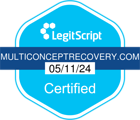It is normal to feel anxiety from time to time. Whether it is interviewing for a job, driving in rush hour traffic, or taking an exam, anxiety can help you focus and motivate you to do your best. In most cases, feelings of anxiousness will gradually dissipate when a stress-inducing situation resolves itself. However, if the anxiety you feel continues and it negatively impacts your daily thoughts and life, you may be dealing with an anxiety disorder.
If you suffer from an anxiety disorder, you aren’t alone. According to information provided by the National Institute on Mental Health, over 40 million adults in the U.S. have an anxiety disorder, while approximately 7% of children aged 3-17 experience issues with anxiety each year. In order to get the help you need, you need to know what anxiety order is, the types of anxiety disorder you can experience, and where you can get specialized treatment.
Multi-Concept Recovery is an outpatient rehab program in Burbank, CA. Contact us today to learn more.
What is an Anxiety Disorder?
Anxiety disorders can be seen as a cluster of disorders in which constant and excessive fear is the common thread. When someone is experiencing different types of anxiety disorders, the fear they internalize oftentimes are situations that aren’t life-threatening. Anxiety disorders are often severe enough that people will avoid situations that may trigger or make their symptoms worse.
Several possible underlying factors can make some people more susceptible to developing different anxiety disorders. These underlying factors are the following:
- Genetics/Heredity
- Brain chemistry
- Environmental stresses
- Substance misuse or withdrawal
- Medical conditions such as those that affect the heart, thyroid, and lungs
How is an Anxiety Disorder Different From Standard Feelings of Anxiety?
All people feel moments of anxiety regularly in their daily lives, but these regular everyday occurrences of anxiety do not mean they have an anxiety disorder. In fact, there are some distinct differences between an anxiety disorder and standard anxiety. For those who experience standard anxiety, the source of their anxiety is related to a specific situation or problem. Also, the anxiety someone feels lasts only as long as the situation is proportional to that situation, and people react to that situation in the appropriate manner.
For those who may experience different types of anxiety disorders, the anxiety they experience is unrealistic, and there may be no immediate threat or danger. Their response to anxiety is often stronger than normal and will come up unexpectedly, oftentimes for no reason. Even when the threat passes, people still feel considerable anxiety, and they feel they can’t manage their anxiety. They will most likely avoid those environments and situations that may trigger their anxiety.
There are also tell-tale signs that people are experiencing some type of anxiety disorder. These include the following:
- Overwhelming feelings of dread
- Restlessness
- Racing heartbeat and sweating
- Headaches
- Fatigue
- Insomnia
- Tremors or twitches
What are the Different Types of Anxiety Disorder?
Anxiety disorders aren’t a “catch-all” condition; there are several types of anxiety orders you can experience. The types of anxiety disorder that can be expressed are the result of different underlying factors. The following are the common types of anxiety disorders:
- Generalized Anxiety Disorder (GAD): this type of anxiety disorder produces chronic worrying about everyday life. It can be all-consuming, and people have problems fulfilling their work, school, and family obligations.
- Social Anxiety Disorder: this anxiety disorder creates intense fear for people in social interactions. Often, people fear being humiliated or being seen as stupid. As a result, they may not say anything or participate in discussions.
- Panic Disorder: this type of anxiety disorder is characterized by panic attacks and feelings of terror that sometimes come out of nowhere. People with a panic disorder experience dizziness, heart palpitations, upset stomach, and shortness of breath. People with panic disorder will avoid social interactions at all costs to avoid feeling symptoms.
- PTSD: PTSD that can develop after exposure to a terrifying event or ordeal such as violent personal assaults, natural or human-caused disasters, accidents, or military combat.
- Phobias: Phobias develop as a result of people fearing certain objects, events, or places. These include agoraphobia, separation anxiety, and even substance abuse and withdrawal.
How to Find Anxiety Treatment Programs
Struggling with an anxiety disorder is emotionally and physically drained. Those who struggle with different anxiety disorder types often feel they are waging a losing battle. Fortunately, there are many rehabs that offer quality anxiety treatment programs. If you are searching for Southern California addiction treatment and need help, call MCR today. We feature effective treatment programs and services for many types of anxiety disorders. These programs are customized to fit your unique needs and can change as your needs change.
End the frustration and suffering of your anxiety disorder; call MCR right now to learn more about our Burbank rehab center.
